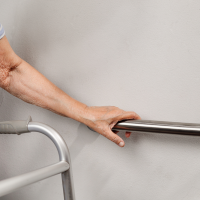5 Ways to Reduce Falls

According to the Center for Disease Control and Prevention, 1 in three seniors will experience a fall in any given year. What’s even more alarming is that less than half will tell their doctor about the fall. When you consider that falls are the leading cause of injuries to seniors, this is an issue families need to take seriously. Falls can result in a wide range of injuries including: cuts, hip fractures, head injuries, and even fatalities. However, there are practical steps families can take to protect their elderly loved ones.
Clean Up- A clean home is a safe home. Make sure the home is easy to navigate by getting rid of all the clutter that may have accumulated. Keeping hallways and heavy traffic areas of the home free of obstacles is an easy way to promote safety. This should also include repairing falling hazards like loose rugs and wayward floorboards.
Install Handrails- Giving seniors an extra point of contact can shore up balance deficiencies. Put in handrails in areas like hallways, showers, around the toilet, and other accident-prone areas to give seniors one more way to stay safe.
Light it Up- One often overlooked fall instigator is poor lighting. When hallways and stairwells are poorly lit, it can be hard to know where to step and identify hazards. Motion-activated night lights are also a great idea to create a safe environment at any time of the day.
Proper Footwear- A good pair of shoes with a non-slip sole is the ideal kind of footwear. However, some seniors prefer to just wear socks. If this is the case, opting for socks with grips on the bottoms can be a nice compromise. However, shoes are still the best option.
Non-Slip Mats- Floor surfaces that will frequently have water on them should have non-slip mats. This includes showers, tubs, bathroom floors, and kitchen floors. Doing so will give seniors a safe point of contact when conditions are slippery.